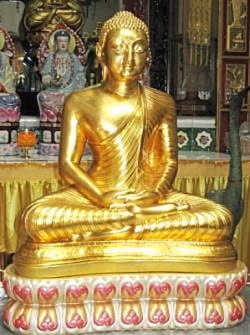Amida the Infinite
by Zuio H. Inagaki
The majestic Light of Amida, which is above all forms and concepts, is beyond description;
Hence, we call him the 'Buddha of Ineffable Light'.
The Light of the one who became a Buddha through the Vow of Infinite Light
Is praised by all the Buddhas. (Jodo Wasan 12)
The most important terms in Buddhism are undoubtedly 'Buddha' and 'Dharma'. As Buddhism developed over a long time, these terms have acquired new dimensions of meaning. Thus 'Buddha' is interpreted in various ways in different sects and schools, although, when it is used in ordinary parlance, the term refers to a historical Buddha, particularly Shakyamuni, the founder of Buddhism. In Zen, 'Buddha' is none other than the ultimate reality, which transcends all verbal expressions and concepts, and is only intuitively known through intensive meditation. Generally, in the Mahayana, three Buddha-bodies are distinguished: (1) Dharma-body (dharmakaya), Buddha as ultimate reality; (2) Reward-body (sambhogakaya), Buddha as the embodiment of perfect merit and virtue; and (3) Transformed body (nirmanakaya), Buddha as incarnated in the form of a man, god, etc., or as apparitional bodies.
According to the Larger Sutra, Amida became a Buddha ten kalpas ago, and is possessed of perfect merit from the Bodhisattva practices that he had performed for an immeasurably long time. Therefore, Amida is a Reward-body Buddha, as Shan-tao confirmed. As such, Amida manifests a glorious, luminous body of cosmic dimensions, which sends forth innumerable rays of light to illumine and save suffering beings in Samsara. He is also possessed of supernal powers, capable of endowing us with merit and power and of perceiving and responding to our feelings and acts, all in accordance with the Vows, which he made when he was a Bodhisattva.
Notwithstanding the fact that Amida is a Buddha having a distinct Person, he as the Dharma-body Buddha shares the supreme essence with other Buddhas. From the perspective of the Dharma-body, all Buddhas are one and the same, and identical with the ultimate reality. It follows then that the terms used in the Mahayana to describe the ultimate state of things, such as 'Thusness', 'True Thusness', 'Suchness', and 'Dharma-nature', are synonyms of the 'Dharma-body Buddha'.
Shinran accepted the traditional interpretation of Amida as a Sambhogakaya Buddha but, at the same time, conceived of him as an undivided totality of the three bodies; as he says in the Kyogyoshinsho, Chapter on Enlightenment:
'Arising from Suchness, Amida Buddha manifests the various Recompensed, Accommodated and Transformed bodies.'
The essential body of Amida is transcendent and indefinable, but it naturally finds innumerable expressions in accordance with the needs of those to be saved and enlightened. Thus the Nameless Amida came to assume a unique name and form with special attributes. The vital agent in this self-manifestation is the Vow, especially the Twelfth Vow in which Dharmakara proclaimed that he would become a Buddha of Infinite Light. Hence, Shinran says in the Notes on Essentials of Faith Alone:
'Amida appeared from Suchness in the form of an Expedient Dharma-Body, called Dharmakara, and made the inconceivable, great Vows, by which he manifested himself as what Vasubandhu called "the Buddha of Unhindered Light Shining Throughout the Ten Quarters".'
It is significant that 'Amida' literally means 'infinite'; his infinite wisdom, compassion and power extend to the farthest limits of existence, embracing all beings. One who awakens to Amida's everlasting presence and his Light of Wisdom finds in him the Ultimate Refuge where true peace resides.
